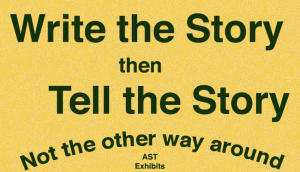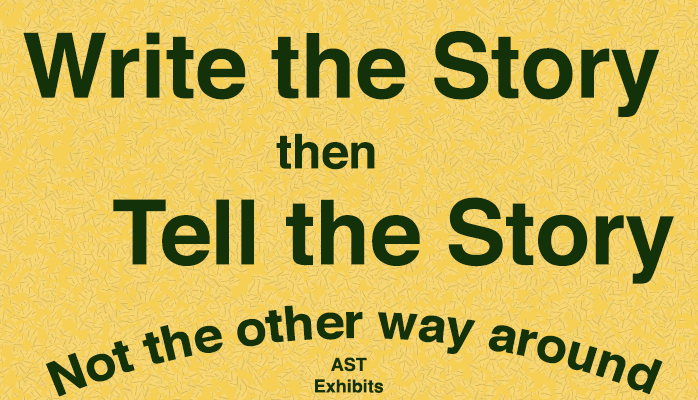When I sit with clients for the first time to discuss their exhibits, they frequently begin the conversation by talking about different ways they want to tell their story even though they aren’t yet totally clear on what that story is. Sure, they know the subject and some of the plot points, but it is not yet a story.
It reminds me of a conversation I once had with a theater professor. He is a master at telling stories on the stage primarily through directing. He knows how to interpret a playwright’s material and transfer it from a script to real flesh and blood characters. We were talking about directing plays and the different approaches that directors can take with the same material.
He reminded me that everything is in the script. If you choose a great script, all you have to do is keep things simple and not get in the way of that script. Choose a great story and tell it simply and honestly.
His point was twofold. First, the single biggest limiting factor in any production is the script. The story that you tell can only be as good as the story itself. And second, that once you have a great story, you need to stay out of its way.
The same is true with exhibit design.

How to design great museum exhibits
Write The Story First
I always begin the exhibit design process by crafting a narrative and then working with my client to refine it into a compelling story. Once we know what the story is, we can then begin to find the best way to tell it.
Crafting the story is a process. It takes an open mind, a soft ego, and the ability to collaborate with other strong personalities. Sometimes we complete the narrative before moving on to the design process and sometimes we leave gaps to fill in as we go.
Write the story first, then tell it. Not the other way around. If the story is not compelling, no amount of storytelling wizardry can save it.
Then Tell the Story
Next, we can look at how best to tell the story. We look at space planning, storytelling techniques, technologies, artifacts, and learning styles. We look for the best way to connect with guests. We are careful not to let the exhibits themselves get in the way of the story we worked so hard to craft. After all, we want our guests to remember the story, not how we told it.
Don’t get in the way.
We are always wary of distractions. If something is not necessary to the story and does not add much to the discussion then it is a distraction that is not needed. We want our audience to feel an emotional connection and don’t want anything including ourselves to get in the way.
It is as true with museum exhibits as it is in the theater, the concert stage, or even on a canvas. Your goal is a compelling story presented simply and honestly. If you can do that, you can create a meaningful connection and experience for your guests.

